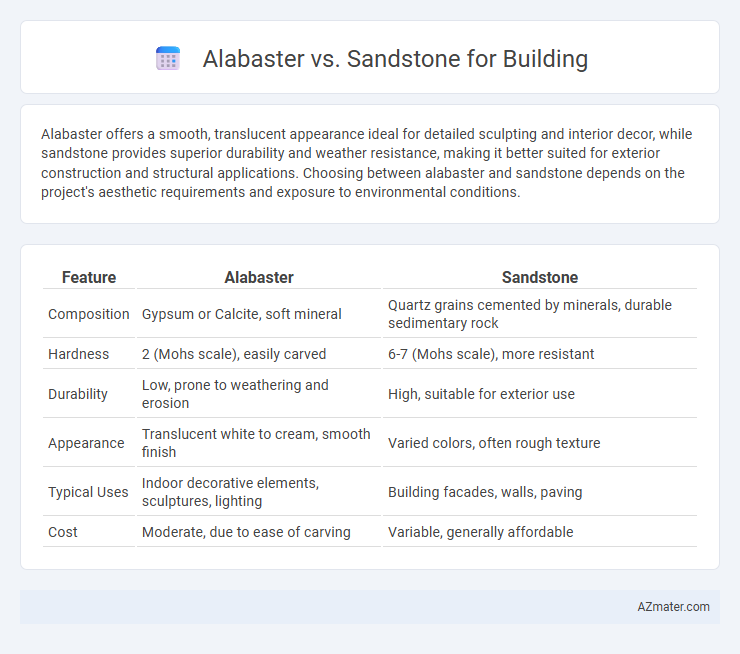Alabaster offers a smooth, translucent appearance ideal for detailed sculpting and interior decor, while sandstone provides superior durability and weather resistance, making it better suited for exterior construction and structural applications. Choosing between alabaster and sandstone depends on the project's aesthetic requirements and exposure to environmental conditions.
Table of Comparison
| Feature | Alabaster | Sandstone |
|---|---|---|
| Composition | Gypsum or Calcite, soft mineral | Quartz grains cemented by minerals, durable sedimentary rock |
| Hardness | 2 (Mohs scale), easily carved | 6-7 (Mohs scale), more resistant |
| Durability | Low, prone to weathering and erosion | High, suitable for exterior use |
| Appearance | Translucent white to cream, smooth finish | Varied colors, often rough texture |
| Typical Uses | Indoor decorative elements, sculptures, lighting | Building facades, walls, paving |
| Cost | Moderate, due to ease of carving | Variable, generally affordable |
Introduction to Alabaster and Sandstone in Construction
Alabaster is a fine-grained, translucent sedimentary rock primarily composed of gypsum, valued in construction for its smooth texture and ease of carving, often used for decorative elements and interior applications. Sandstone, a clastic sedimentary rock comprised mainly of sand-sized mineral particles or rock fragments, offers durability and strength ideal for structural components, exterior walls, and paving. Both materials provide unique aesthetic and functional qualities, with alabaster preferred for intricate design work and sandstone favored for its weather resistance and load-bearing capabilities.
Geological Origins and Formation
Alabaster, a fine-grained form of gypsum or calcite, originates from the sedimentary evaporation of mineral-rich waters in ancient lakes and seas, resulting in its smooth, translucent texture ideal for detailed carving in building applications. Sandstone forms from compacted and cemented sand-sized mineral particles, primarily quartz, deposited over millions of years in riverbeds, beaches, or deserts, giving it a durable and coarse-grained structure suited for robust architectural use. The distinct geological formation processes lead alabaster to be softer and more workable, while sandstone offers greater strength and weather resistance in construction.
Physical Properties Comparison
Alabaster exhibits a fine-grained, translucent texture with a Mohs hardness of 2, making it relatively soft and suitable for intricate carvings but less durable for structural applications. Sandstone, with a coarser grain and hardness ranging from 6 to 7 on the Mohs scale, offers greater compressive strength and weather resistance, ideal for exterior building facades and load-bearing structures. Both stones vary in porosity, with sandstone generally having higher permeability, impacting its susceptibility to moisture absorption and erosion over time.
Aesthetic Appeal and Color Variations
Alabaster offers a smooth, translucent aesthetic with creamy white to soft beige tones, ideal for elegant, refined architectural details. Sandstone provides a broader color palette, ranging from warm reds and browns to yellows and grays, contributing to rustic and natural building designs. The choice between alabaster and sandstone hinges on desired visual texture and color depth, with alabaster emphasizing luminosity and sandstone showcasing earthy diversity.
Durability and Weather Resistance
Alabaster, a softer and more porous material, generally lacks the durability and weather resistance needed for exterior building applications compared to sandstone. Sandstone exhibits higher hardness and superior resistance to weathering, making it ideal for long-lasting structural elements and facades in various climates. Its natural composition allows sandstone to withstand freeze-thaw cycles and erosion better than alabaster, ensuring greater longevity in building projects.
Workability and Ease of Carving
Alabaster offers superior workability and ease of carving compared to sandstone due to its softer, finer-grained texture, allowing for intricate detailing and smooth finishes. Sandstone, being a harder and coarser material, requires more effort and specialized tools to shape, making it less ideal for delicate or precise sculptural work. The malleability of alabaster makes it a preferred choice for artisans seeking to create detailed architectural elements or decorative features.
Cost and Availability
Alabaster is generally more expensive and less widely available than sandstone, making it a less common choice for large-scale building projects. Sandstone offers greater affordability and abundant accessibility, especially in regions with natural sandstone quarries. Cost-efficiency and regional availability often make sandstone the preferred material for construction over alabaster.
Common Architectural Uses
Alabaster is prized in architectural applications for its smooth texture and translucency, making it ideal for interior features such as decorative panels, light diffusers, and intricate carvings. Sandstone, valued for its durability and natural earthy tones, is frequently utilized in exterior facades, paving, and structural elements where weather resistance is essential. Both materials offer distinctive aesthetic and functional benefits, influencing their selection based on project requirements and environmental conditions.
Maintenance and Longevity
Alabaster requires more frequent sealing and careful maintenance due to its softness and susceptibility to scratching and moisture damage, making it less durable for high-traffic or exterior applications. Sandstone offers greater longevity and resistance to weathering, requiring less intensive upkeep, which makes it ideal for outdoor structures and long-term building projects. Proper sealing and periodic cleaning can extend the lifespan of both materials, but sandstone generally delivers superior durability and lower maintenance costs over time.
Environmental Impact and Sustainability
Alabaster is a soft, fine-grained mineral primarily composed of gypsum or calcite, resulting in lower durability and a higher susceptibility to weathering compared to sandstone, which is a hard, granular sedimentary rock composed mainly of quartz and feldspar. From an environmental perspective, sandstone's abundant availability and longevity reduce the frequency of replacement and associated resource consumption, while alabaster's extractive processes often involve more intensive quarrying with greater ecological disturbance. Sandstone's resilience contributes to building sustainability by minimizing material waste and energy expenditure over time, making it a more environmentally responsible choice for durable construction.

Infographic: Alabaster vs Sandstone for Building
 azmater.com
azmater.com